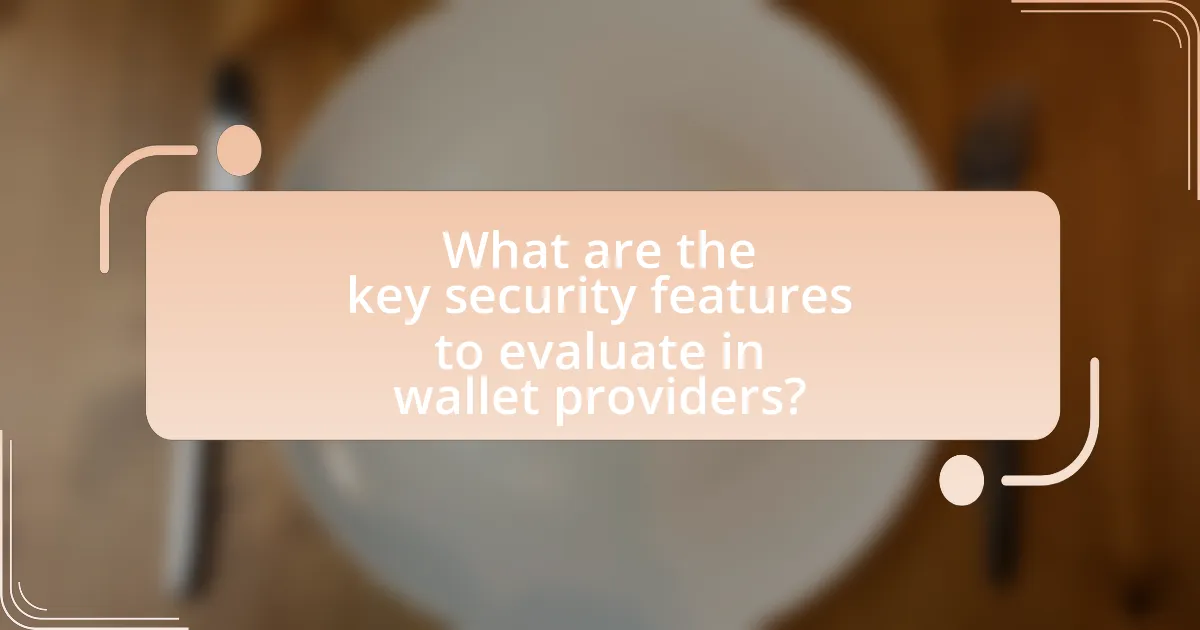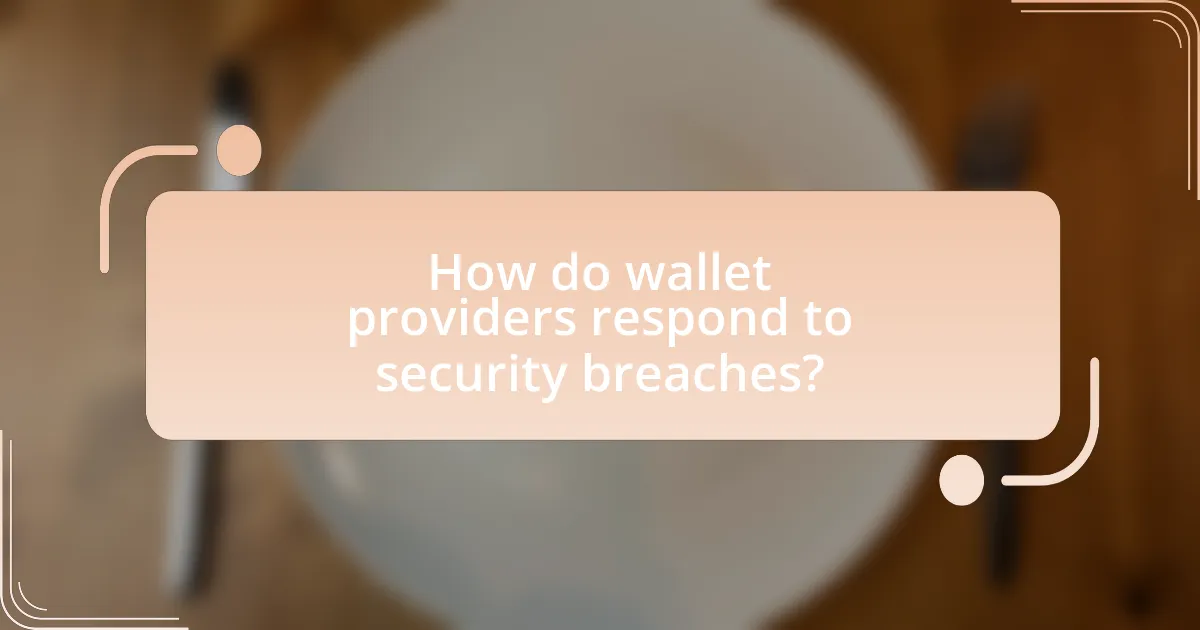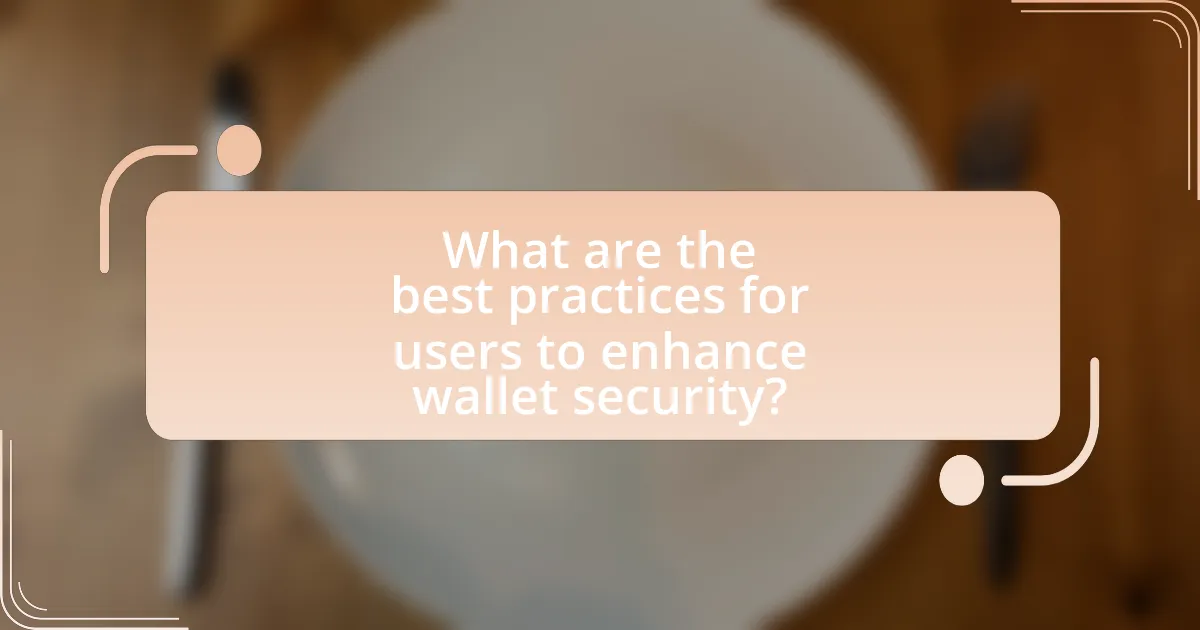The article focuses on evaluating the security features of different wallet providers, emphasizing critical aspects such as two-factor authentication (2FA), encryption protocols, backup and recovery options, and cold storage capabilities. It details how various wallet providers protect user data through encryption, secure storage practices, and authentication measures, including biometric verification and multi-signature technology. Additionally, the article addresses common vulnerabilities, the effectiveness of security measures, and the importance of compliance with regulations. Best practices for users to enhance wallet security and factors to consider when selecting a secure wallet provider are also discussed, providing a comprehensive overview of the security landscape in digital wallets.

What are the key security features to evaluate in wallet providers?
The key security features to evaluate in wallet providers include two-factor authentication (2FA), encryption protocols, backup and recovery options, and cold storage capabilities. Two-factor authentication enhances security by requiring a second form of verification, reducing the risk of unauthorized access. Encryption protocols protect user data and transactions from interception, ensuring confidentiality. Backup and recovery options are essential for restoring access to funds in case of device loss or failure, while cold storage capabilities safeguard assets by keeping them offline, minimizing exposure to online threats. These features collectively contribute to a robust security framework, essential for protecting digital assets.
How do different wallet providers ensure user data protection?
Different wallet providers ensure user data protection through a combination of encryption, two-factor authentication, and secure storage practices. Encryption protects user data by converting it into a format that is unreadable without a decryption key, making it difficult for unauthorized parties to access sensitive information. Two-factor authentication adds an extra layer of security by requiring users to verify their identity through a second method, such as a text message or authentication app, before accessing their accounts. Additionally, secure storage practices, such as using hardware wallets or cold storage, minimize the risk of online attacks by keeping private keys offline. These measures collectively enhance the overall security of user data in digital wallets.
What encryption methods are commonly used by wallet providers?
Wallet providers commonly use encryption methods such as AES (Advanced Encryption Standard), RSA (Rivest-Shamir-Adleman), and ECC (Elliptic Curve Cryptography). AES is widely adopted for encrypting sensitive data due to its efficiency and security, utilizing key sizes of 128, 192, or 256 bits. RSA is often employed for secure data transmission and digital signatures, relying on the mathematical difficulty of factoring large prime numbers. ECC is favored for its strong security with smaller key sizes, making it efficient for mobile and resource-constrained environments. These methods are integral to ensuring the confidentiality and integrity of user data in digital wallets.
How do wallet providers manage private keys securely?
Wallet providers manage private keys securely by employing a combination of encryption, hardware security modules, and multi-signature technology. Encryption ensures that private keys are stored in a format that is unreadable without the correct decryption key, protecting them from unauthorized access. Hardware security modules provide a physical layer of security, storing keys in a secure environment that is resistant to tampering and attacks. Multi-signature technology requires multiple keys to authorize a transaction, adding an additional layer of security by ensuring that no single entity has complete control over the funds. These methods collectively enhance the security of private key management, reducing the risk of theft and unauthorized access.
What authentication measures do wallet providers implement?
Wallet providers implement several authentication measures to enhance security, including two-factor authentication (2FA), biometric verification, and multi-signature wallets. Two-factor authentication requires users to provide a second form of identification, such as a code sent to their mobile device, in addition to their password, significantly reducing the risk of unauthorized access. Biometric verification utilizes unique physical characteristics, such as fingerprints or facial recognition, to ensure that only the authorized user can access the wallet. Multi-signature wallets require multiple private keys to authorize a transaction, adding an extra layer of security by distributing control among several parties. These measures collectively strengthen the security framework of wallet providers, making it more difficult for malicious actors to compromise user accounts.
How effective are two-factor authentication systems in wallet security?
Two-factor authentication systems are highly effective in enhancing wallet security. They add an additional layer of protection by requiring not only a password but also a second form of verification, such as a code sent to a mobile device. This significantly reduces the risk of unauthorized access, as even if a password is compromised, the attacker would still need the second factor to gain entry. According to a study by Google, two-factor authentication can block up to 99% of automated attacks, demonstrating its robustness in safeguarding sensitive information.
What role does biometric authentication play in securing wallets?
Biometric authentication plays a crucial role in securing wallets by providing a unique and personal method of verifying user identity. This technology utilizes physical characteristics, such as fingerprints, facial recognition, or iris scans, which are difficult to replicate or forge. According to a study by the National Institute of Standards and Technology, biometric systems can significantly reduce the risk of unauthorized access compared to traditional password-based systems, which are often vulnerable to theft or guessing. By integrating biometric authentication, wallet providers enhance security, ensuring that only authorized users can access their digital assets.
What are the common vulnerabilities associated with wallet providers?
Common vulnerabilities associated with wallet providers include inadequate encryption, phishing attacks, and insecure private key management. Inadequate encryption can lead to unauthorized access to sensitive data, as seen in breaches where attackers exploited weak encryption protocols. Phishing attacks target users to steal credentials, with reports indicating that over 90% of cyberattacks involve phishing tactics. Insecure private key management, where users fail to securely store their keys, can result in loss of funds, as evidenced by numerous incidents where users lost access to their wallets due to compromised key storage practices.
How do phishing attacks target wallet users?
Phishing attacks target wallet users by impersonating legitimate services to steal sensitive information such as private keys and login credentials. Attackers often create fake websites or send fraudulent emails that appear to be from trusted wallet providers, tricking users into entering their information. According to the Anti-Phishing Working Group, there were over 200,000 phishing attacks reported in the first quarter of 2023 alone, highlighting the prevalence of this threat. These tactics exploit the trust users place in recognized brands, making it crucial for wallet providers to implement robust security measures to protect their customers.
What are the implications of software vulnerabilities in wallet applications?
Software vulnerabilities in wallet applications can lead to significant financial losses and compromise user data. These vulnerabilities may allow unauthorized access to users’ funds, enabling attackers to execute transactions without consent. For instance, a study by the Ponemon Institute found that 60% of organizations experienced a data breach due to software vulnerabilities, highlighting the critical need for robust security measures in wallet applications. Additionally, the presence of vulnerabilities can erode user trust, resulting in decreased adoption rates and potential regulatory scrutiny. Therefore, addressing software vulnerabilities is essential for maintaining the integrity and security of wallet applications.

How do wallet providers respond to security breaches?
Wallet providers typically respond to security breaches by implementing immediate measures to secure their systems, notifying affected users, and conducting thorough investigations. For instance, after a breach, providers often enhance their security protocols, such as increasing encryption standards and employing multi-factor authentication to prevent future incidents. Additionally, they may offer compensation or support to affected users, as seen in cases like the 2016 Bitfinex hack, where the exchange provided a recovery plan for impacted customers. These actions demonstrate a commitment to user security and trust restoration following a breach.
What incident response strategies do wallet providers have in place?
Wallet providers implement several incident response strategies to mitigate risks and address security breaches effectively. These strategies typically include real-time monitoring of transactions to detect suspicious activities, immediate freezing of accounts upon detection of unauthorized access, and comprehensive incident reporting protocols to inform users and regulatory bodies. Additionally, wallet providers often conduct regular security audits and vulnerability assessments to identify and rectify potential weaknesses in their systems. For instance, a study by the Cybersecurity & Infrastructure Security Agency highlights that proactive incident response planning significantly reduces the impact of security incidents on financial services.
How do wallet providers communicate with users during a security breach?
Wallet providers communicate with users during a security breach primarily through direct notifications via email, in-app alerts, and official website announcements. These communications typically inform users about the nature of the breach, the potential impact on their accounts, and recommended actions to secure their information. For instance, a study by the Ponemon Institute found that 70% of companies notify affected customers within a week of a breach, emphasizing the importance of timely communication. Additionally, wallet providers may also utilize social media channels to disseminate information quickly and reach a broader audience.
What measures are taken to prevent future breaches after an incident?
To prevent future breaches after an incident, wallet providers implement a combination of enhanced security protocols, regular audits, and employee training. Enhanced security protocols may include multi-factor authentication, encryption of sensitive data, and real-time monitoring of transactions to detect anomalies. Regular audits help identify vulnerabilities in the system, allowing for timely updates and patches. Employee training ensures that staff are aware of security best practices and potential threats, reducing the risk of human error. These measures are supported by industry standards and compliance requirements, such as the Payment Card Industry Data Security Standard (PCI DSS), which mandates specific security practices to protect cardholder data.
How do wallet providers ensure compliance with security regulations?
Wallet providers ensure compliance with security regulations by implementing robust security protocols, conducting regular audits, and adhering to industry standards such as PCI DSS (Payment Card Industry Data Security Standard). These providers utilize encryption technologies to protect user data and transactions, ensuring that sensitive information is securely stored and transmitted. Additionally, they often engage third-party security firms to perform vulnerability assessments and penetration testing, which helps identify and mitigate potential security risks. Compliance with regulations is further supported by maintaining transparent reporting practices and user authentication measures, which are essential for safeguarding against fraud and unauthorized access.
What regulations must wallet providers adhere to for user security?
Wallet providers must adhere to regulations such as the Anti-Money Laundering (AML) laws, the Know Your Customer (KYC) requirements, and the General Data Protection Regulation (GDPR) to ensure user security. AML laws require wallet providers to monitor transactions for suspicious activity, while KYC mandates the verification of user identities to prevent fraud. GDPR establishes guidelines for data protection and privacy, ensuring that user data is handled securely and transparently. Compliance with these regulations is essential for maintaining user trust and safeguarding sensitive information in the digital wallet ecosystem.
How do compliance requirements vary across different regions?
Compliance requirements vary significantly across different regions due to varying legal frameworks, cultural norms, and regulatory bodies. For instance, the European Union enforces the General Data Protection Regulation (GDPR), which mandates strict data protection and privacy standards, while the United States has a more fragmented approach with regulations like the California Consumer Privacy Act (CCPA) and sector-specific laws. Additionally, regions like Asia may have their own unique compliance requirements, such as the Personal Data Protection Act (PDPA) in Singapore, which emphasizes consent and data protection. These differences can impact how wallet providers implement security features, as they must adapt to the specific legal obligations and consumer expectations of each region.

What are the best practices for users to enhance wallet security?
To enhance wallet security, users should implement multi-factor authentication (MFA), use strong, unique passwords, and regularly update their software. Multi-factor authentication adds an extra layer of security by requiring additional verification beyond just a password, significantly reducing the risk of unauthorized access. Strong, unique passwords prevent easy guessing or brute-force attacks, while regular software updates ensure that any vulnerabilities are patched, protecting against potential exploits. According to a study by the Cybersecurity & Infrastructure Security Agency, using MFA can block 99.9% of automated attacks, highlighting its effectiveness in enhancing security.
How can users choose a secure wallet provider?
Users can choose a secure wallet provider by assessing key security features such as encryption methods, two-factor authentication, and the provider’s track record in handling security breaches. A wallet provider that employs strong encryption protocols, like AES-256, ensures that user data is protected against unauthorized access. Additionally, two-factor authentication adds an extra layer of security, requiring users to verify their identity through a secondary method, which significantly reduces the risk of unauthorized transactions. Furthermore, examining the provider’s history regarding security incidents can provide insights into their reliability; for instance, providers with a history of prompt responses to breaches and transparent communication are generally more trustworthy.
What factors should users consider when evaluating wallet security features?
Users should consider encryption methods, two-factor authentication, backup options, and recovery processes when evaluating wallet security features. Encryption methods protect user data by converting it into a secure format, making it unreadable without the correct key. Two-factor authentication adds an extra layer of security by requiring a second form of verification, significantly reducing the risk of unauthorized access. Backup options ensure that users can recover their funds in case of device loss or failure, while robust recovery processes provide a clear path for regaining access to the wallet. These factors are critical as they directly impact the overall security and reliability of the wallet, ensuring that users’ assets remain protected against theft and loss.
How can user reviews and ratings inform wallet security choices?
User reviews and ratings can significantly inform wallet security choices by providing real-world insights into the experiences of other users regarding security features. These reviews often highlight specific vulnerabilities, successful security measures, and the overall reliability of wallet providers. For instance, a study by the University of Cambridge found that user feedback on security incidents can lead to a 30% increase in awareness and adoption of more secure wallet options. Additionally, high ratings often correlate with robust security protocols, such as two-factor authentication and encryption practices, which are frequently mentioned in user testimonials. Thus, analyzing user reviews and ratings allows potential users to make informed decisions based on collective experiences and documented security performance.
What steps can users take to protect their wallets from threats?
Users can protect their wallets from threats by implementing strong security measures such as enabling two-factor authentication (2FA), using hardware wallets, and regularly updating software. Two-factor authentication adds an extra layer of security by requiring a second form of verification, significantly reducing the risk of unauthorized access. Hardware wallets store private keys offline, making them less vulnerable to online attacks. Regular software updates ensure that users benefit from the latest security patches, which can protect against newly discovered vulnerabilities. According to a report by the Cybersecurity & Infrastructure Security Agency, using these methods can reduce the likelihood of wallet compromise by up to 90%.
How important is regular software updating for wallet security?
Regular software updating is crucial for wallet security as it addresses vulnerabilities and enhances protection against emerging threats. Software updates often include patches for security flaws that could be exploited by attackers, thereby reducing the risk of unauthorized access to wallet data. For instance, a study by the Cybersecurity & Infrastructure Security Agency (CISA) found that 85% of successful cyberattacks exploit known vulnerabilities for which patches are available. This statistic underscores the importance of keeping wallet software up to date to mitigate risks and ensure robust security.
What role does user education play in preventing security issues?
User education plays a critical role in preventing security issues by equipping individuals with the knowledge and skills necessary to recognize and mitigate potential threats. Educated users are more likely to identify phishing attempts, use strong passwords, and implement two-factor authentication, which significantly reduces the risk of unauthorized access. Studies indicate that organizations with comprehensive security training programs experience 70% fewer security incidents compared to those without such initiatives. This correlation underscores the importance of user education as a proactive measure in enhancing overall security posture.